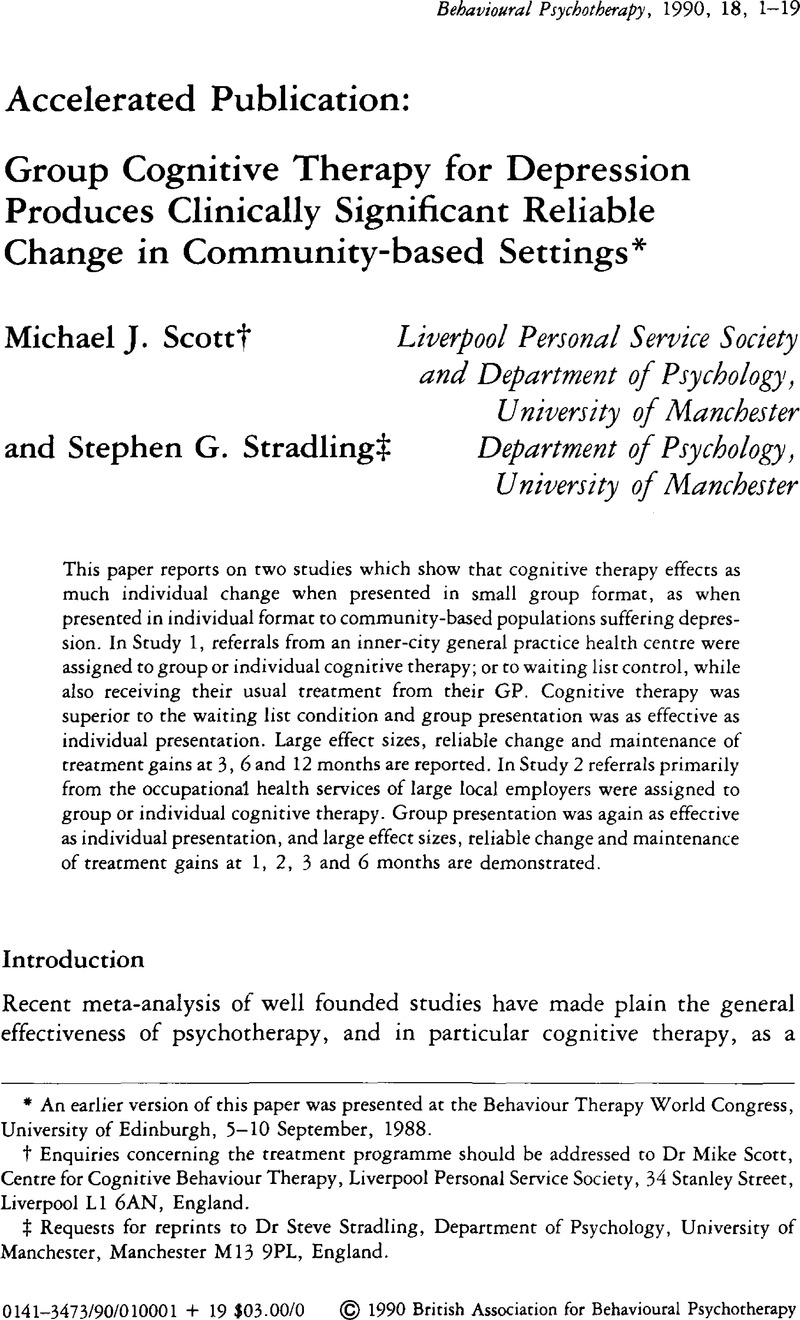Crossref Citations
This article has been cited by the following publications. This list is generated based on data provided by Crossref.
Satterfield, Jason M.
1994.
Integrating group dynamics and cognitive-behavioral groups: A hybrid model..
Clinical Psychology: Science and Practice,
Vol. 1,
Issue. 2,
p.
185.
Stravynski, A.
Verreault, R.
Gaudette, G.
Langlois, R.
Gagnier, S.
and
Larose, M.
1994.
The Treatment of Depression with Group Behavioural-Cognitive Therapy and Imipramine.
The Canadian Journal of Psychiatry,
Vol. 39,
Issue. 7,
p.
387.
Jarrett, Robin B.
and
John Rush, A.
1994.
Short-Term Psychotherapy of Depressive Disorders.
Psychiatry,
Vol. 57,
Issue. 2,
p.
115.
Morrison, Anthony P.
Scott, Michael J.
and
Stradling, Stephen G.
1995.
Dimensions of coping and life events as predictors of depression following cognitive therapy.
Clinical Psychology & Psychotherapy,
Vol. 2,
Issue. 1,
p.
40.
Bristow, Michael
and
Bright, Jenifer
1995.
Group Cognitive Therapy in Chronic Depression: Results From Two Intervention Studies.
Behavioural and Cognitive Psychotherapy,
Vol. 23,
Issue. 4,
p.
373.
Anderson, Kay
and
White, Jim
1996.
Evaluation of an opt-in system in primary care psychology.
Clinical Psychology Forum,
Vol. 1,
Issue. 93,
p.
28.
Crook, Patricia
Rose, Michael
Salmon, Peter
Stott, Rachel
Peters, Sarah
and
Stanley, Ian
1998.
Adherence to Group Exercise.
Physiotherapy,
Vol. 84,
Issue. 8,
p.
366.
Peterson, Alan L.
and
Halstead, T. Scott
1998.
Group cognitive behavior therapy for depression in a community setting: A clinical replication series.
Behavior Therapy,
Vol. 29,
Issue. 1,
p.
3.
Frank, PhD, Ellen
and
Thase, MD, Michael E.
1999.
Natural History and Preventative Treatment of Recurrent Mood Disorders.
Annual Review of Medicine,
Vol. 50,
Issue. 1,
p.
453.
Rose, Sheldon D.
1999.
A Guide to Starting Psychotherapy Groups.
p.
99.
Ravindran, Arun V.
Anisman, Hymie
Merali, Zul
Charbonneau, Yoland
Telner, John
Bialik, Robert J.
Wiens, Andrew
Ellis, Jack
and
Griffiths, Jenna
1999.
Treatment of Primary Dysthymia With Group Cognitive Therapy and Pharmacotherapy: Clinical Symptoms and Functional Impairments.
American Journal of Psychiatry,
Vol. 156,
Issue. 10,
p.
1608.
Frank, E.
Thase, M. E.
Spanier, C.
Cyranowski, J. M.
and
Siegel, L.
2000.
Psychiatrie der Gegenwart 5.
p.
549.
Stevens, Sean E.
Hynan, Michael T.
and
Allen, Mike
2000.
A meta-analysis of common factor and specific treatment effects across the outcome domains of the phase model of psychotherapy..
Clinical Psychology: Science and Practice,
Vol. 7,
Issue. 3,
p.
273.
Posternak, Michael A.
and
Miller, Ivan
2001.
Untreated short-term course of major depression: a meta-analysis of outcomes from studies using wait-list control groups.
Journal of Affective Disorders,
Vol. 66,
Issue. 2-3,
p.
139.
Patelis-Siotis, Irene
Young, L.Trevor
Robb, Janine C.
Marriott, Michael
Bieling, Peter J.
Cox, Linda C.
and
Joffe, Russell T.
2001.
Group cognitive behavioral therapy for bipolar disorder: a feasibility and effectiveness study.
Journal of Affective Disorders,
Vol. 65,
Issue. 2,
p.
145.
Gelhart, Robert P.
and
King, Heather L.
2001.
The influence of comorbid risk factors on the effectiveness of cognitive-behavioral treatment of depression.
Cognitive and Behavioral Practice,
Vol. 8,
Issue. 1,
p.
18.
Frank, E.
Thase, M. E.
Spanier, C.
Cyranowski, J. M.
and
Siegel, L.
2001.
Contemporary Psychiatry.
p.
1717.
McDermut, Wilson
Miller, Ivan W.
and
Brown, Richard A.
2001.
The efficacy of group psychotherapy for depression: A meta-analysis and review of the empirical research..
Clinical Psychology: Science and Practice,
Vol. 8,
Issue. 1,
p.
98.
Enns, Murray W.
Cox, Brian J.
and
Pidlubny, Shannon R.
2002.
Group Cognitive Behaviour Therapy for Residual Depression: Effectiveness and Predictors of Response.
Cognitive Behaviour Therapy,
Vol. 31,
Issue. 1,
p.
31.
Gelhart, Robert P.
Hand-Ronga, Nancy
and
King, Heather L.
2002.
Group Cognitive-Behavioral Treatment of Depression and the Interaction of Demographic Variables.
Journal of Cognitive Psychotherapy,
Vol. 16,
Issue. 4,
p.
469.




Comments
No Comments have been published for this article.